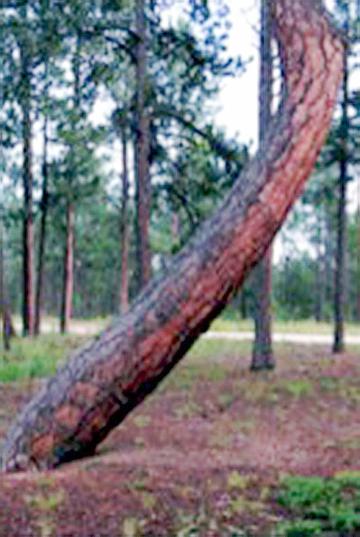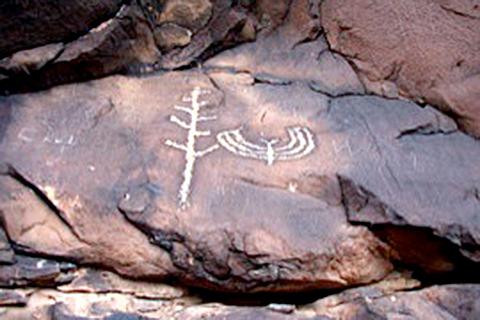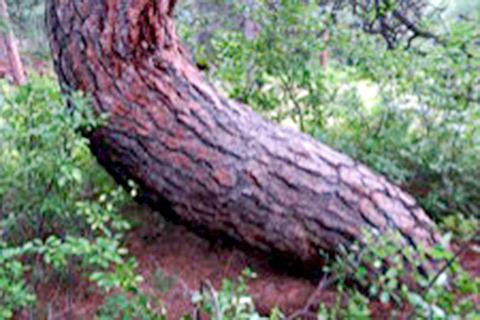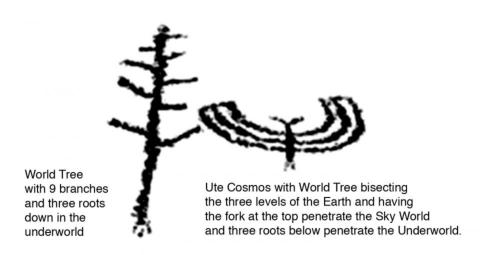 |
Canku Ota
|
 |
|
(Many Paths)
|
||
|
An Online Newsletter
Celebrating Native America
|
||
|
August 2016 - Volume
14 Number 8
|
||
|
|
||
|
Trail Trees Along
The Old Spanish Trail
|
||
|
by The Southern Ute
Drum
|
||
Native Americans traditionally transferred their culture and history through oral means as told by the elders. Each year at festivals and family gatherings, the elders told the stories of their tribe and the mythological stories associated with their culture. Within a short time after the arrival of the white settlers and missionaries, the culture of the Native Americans began to be affected and the oral stories began to disappear. The Utes are a people who lived in the mountains of Colorado, Utah and New Mexico. The traditional hunting grounds extended far beyond that territory. The Utes do not have a migration story like other tribes since their recorded history has always been in the western mountain region. The Ute Nation is composed of several tribal bands that were loosely affiliated in a tribal confederacy. A principal leader was chosen when the tribe had dealings with governmental agencies Important to the Ute Indians were the trail trees and rock art that guided them on their travels. While many of these trees can live to be 300 to 600 years old, some are near the end of their lives. While others, unfortunately have been destroyed by urban development and vandals. The meaning of these trees and rocks are not completely known and may never be known since those who know are all but gone. The Utes bent trees for directional markers to a location often of a sacred nature, to mark sites where a person of importance died or was born, and other special purpose trees. The directional marker trees are often only bent about 30 degrees off of vertical and then allowed to go vertical again. Many of these trees point to Pikes Peak, which is the most sacred site to the Utes. The Utes called Pikes Peak Tavakav or Sun Mountain. Some of the trees and rocks are found marking old Indian trails. Others point to water, shelter, stream crossing and more. The techniques for bending a tree into a particular shape have, for the most part, been lost. These “living artifacts” are a testimony to the skills and knowledge of the Indian people and their being one with nature. The Utes called them Spirit Trees as they were known to hold the prayers and then they go to Creator.
Ute Burial Trees hold a special meaning to the Utes as the cedar tree that has spiritual powers used by medicine people. Clifford Duncan, Ute elder from Fort Duchesne, UT through the works of Carol Patterson has captured a lot of his work on trees and rock art. The stories are beginning to come alive as to the history of the early Utes. The World Tree and Ute Cosmology are all shown in this panel that is placed high up on the cliff face. It belongs to the higher level of knowledge known only to spiritual leaders of the Ute bands. The information was probably discussed among elders and initiated members. The images on this panel were not meant to be viewed by everyone and that is the reason it was not placed down on the valley floor where the general public could see it. The trail does not even go by this panel, because of its religious significance. The Pochteca, Aztec traveling salesman and traders from the Valley of Mexico, were the most likely source of the birds and other exotics found in Chaco Canyon. Exotic indicators of distant trade apart from the macaws are the cocoa beans and chocolate residue found in a group of cylindrical jars excavated at Chaco. These tropical birds and chocolate beans were more than 1,200 miles for their source of origin and must have been carried, like the live Macaws, on the backs of the long distance traders who walked great distances and traded widely for easily transportable merchandise.
I have been working with many scholars and researchers across the United States to find the Mystery of the Trees who are studying what the trees are saying. Many stories are being told and people working on these mysteries are discovering what the old Tribal Spiritual Leaders knew and are now trying to tell us. The old storytellers including myself were told not to tell the secrets of the Native Americans. I am only guiding them to make sure the wrong story is not told. But, many times the wrong story leaks out anyway. New techniques are now being used to help discover the Mysteries of the Trees. We will be holding a series of workshops and conferences to tell what has been discovered about the Mysteries of the Trees. How Pines Were Used Food
They were an important aboriginal food source in most of the west, including the Northwest Plateau home of the Bannocks, Shoshones, Paiutes, Flatheads, and Nez Perces among others (Walker). In the Four Corners country of the Southwest, pinon nuts harvested annually were and area staple food among the Navajos, Utes, and Apaches. Rich in protein, pine nuts, after roasting, were often ground or mixed with grease and ground berries. The mix was then formed into cakes to be stored and used for food throughout the winter. Cambium, sometimes called inner-bark, is a layer of formative cells between the wood bark in woody plants which forms new wood and bark. In pines this is on an annual basis that forms a growth-ring of wood. It is rich in carbohydrates, mostly sugar, starch, and celluloses, and contains calcium oxalate – a white crystalline substance found in plant cells classed as an acid salt as well. Depending upon the tree’s location and the soil it grows in it may furnish, besides calories, protein, fat, crude fiber, ash, and moisture traces minerals, such as phosphorous, magnesium, iron, Zinc, copper magnesium, aluminum, barium, strontium, boron, and chromium (Martorano). Cambium was usually eaten by almost all American Indians living in and around pine forests. The cambium layer and sap of the black pine are eaten especially in the spring, as is western yellow pine. For ponderosa, the outer bark is removed from the young twigs and the cambium is eaten. Pine moss (Alectoria jubata) a lichen gathered from pine trees in the mountains. Two kinds were gathered around the first of July. One dark brown in color and edible; the other, light green in color and edible. Nutritionally, compared with plain shredded wheat, is higher in calcium, fat. Fiber. Ash, and calories, but lower in protein, carbohydrates, phosphorous, and iron. DOWSING – David Johnson During the last forty years I have worked and lived with tribes in remote regions of the world whose lifestyle still resembles that of Native Americans before 1492. (Johnson’s resume on CD) Many of these cultures were located in dry regions similar to the southwest. From time to time I have observed alternate dowsing techniques of groundwater flowing beneath the surface. In the lower Rio Grande de Nasca drainage of Peru at Usaca, residents told my colleagues and I they could hear a waterfall at night when the laid down to sleep, however the river’s surface was dry at that time. In that region a fault, which is deeper that the river valley bottom crossed it. When the subsurface water flowing down the river valley intersects the deeper fault, it flowed out of the river and into the deeper fault, thus creating the underground waterfall the people heard. During the Aja Alto survey my colleagues and I heard groundwater flowing along the fault we were mapping even though there was no indication of water, either surface of subsurface, in the area. (Johnson 2009, Chap 2) Sacred Landscape. Ceremonial Stone Landscape And Habitationscapes 5 Types of Ute Indian Prayer Trees 1 – Burial Trees 2 – Medicine Trees 3 – Story or Message Trees 4 – Trail Marker Trees 5 – Ceremonial Trees The Utes modified trees for navigational, spiritual, burial, medicinal & educational purposes. |
||||||||
|
|
|
|
||
|
|
||
| Canku Ota is a free Newsletter celebrating Native America, its traditions and accomplishments . We do not provide subscriber or visitor names to anyone. Some articles presented in Canku Ota may contain copyright material. We have received appropriate permissions for republishing any articles. Material appearing here is distributed without profit or monetary gain to those who have expressed an interest. This is in accordance with Title 17 U.S.C. Section 107. | ||
|
Canku Ota is a copyright ©
2000 - 2016 of Vicki Williams Barry and Paul Barry.
|
||
 |
 |
|
|
The "Canku
Ota - A Newsletter Celebrating Native America" web site and
its design is the
|
||
|
Copyright ©
1999 - 2016 of Paul C. Barry.
|
||
|
All Rights Reserved.
|
||



